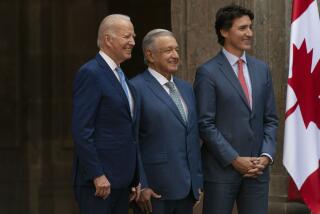New Debt Deal
- Share via
A life ring splashed onto Mexico’s ocean of red ink Tuesday--the first sign in five years that the struggling country need not drown in debt.
Rescue came in the form of $10 billion in U.S. Treasury bonds that Mexico can use as collateral to buy back some of its debts at discount rates from the commercial banks that hold about 80% of its promissory notes.
Because many banks have been selling Mexican loans for about half their face value--when they can find buyers--the Treasury bonds probably can be used to retire substantially more than $10 billion of its $100 billion in debt. But the most encouraging aspect of the U.S. move is that other industrial nations may use this novel approach to help other debtor nations, leaving Mexico and other Third World countries with more capital to invest in economic growth. As things now stand, two-thirds of Mexico’s 1988 government budget is earmarked for interest on loans. The arrangement should release as much as $1 billion of interest payments each year for capital investment.
The idea of using the Treasury bonds to help Mexico stay afloat was conceived in desperationby Mexico and worked out in talks with Morgan Guaranty Trust Co., one of America’s biggest banks. They in turn sold the idea to Washington.
A devalued peso had been pushing up Mexican exports, and the country was moving--albeit slowly--back from the economic cliff of default on all its borrowings. Then came the global crash of stock markets in October, a new wave of capital flight and the prospect of prolonging even further the austerity programs, with their grim effect on the poor, that already threatened to lead to political upheaval. Once again some Mexican political leaders began calling for default.
Under the arrangement, Mexico will pay $2 billion for the U.S. bonds. Those will be used as collateral for an issue of $10 billion in Mexican bonds, the proceeds of which will be used to pay off some of its debt. Mexico’s recent export boom has built up foreign-exchange reserves of $11 billion--more than enough to handle the transaction.
The move is not a panacea, but as a pattern among industrial nations for dealing with Third World debt it would allow many of them to invest money that now disappears into interest payments in long-term growth ventures. The alternative for Mexico and other Latin American nations is to squeeze money for capital investment out of budgets that already are too meager to help people mired in poverty. Economic growth is the Third World’s only reliable path out of such poverty, just as it is the only alternative worldwide to stagnation and recession. All the more reason for other industrial nations to applaud and follow the United States’ lead.
More to Read
Sign up for Essential California
The most important California stories and recommendations in your inbox every morning.
You may occasionally receive promotional content from the Los Angeles Times.










